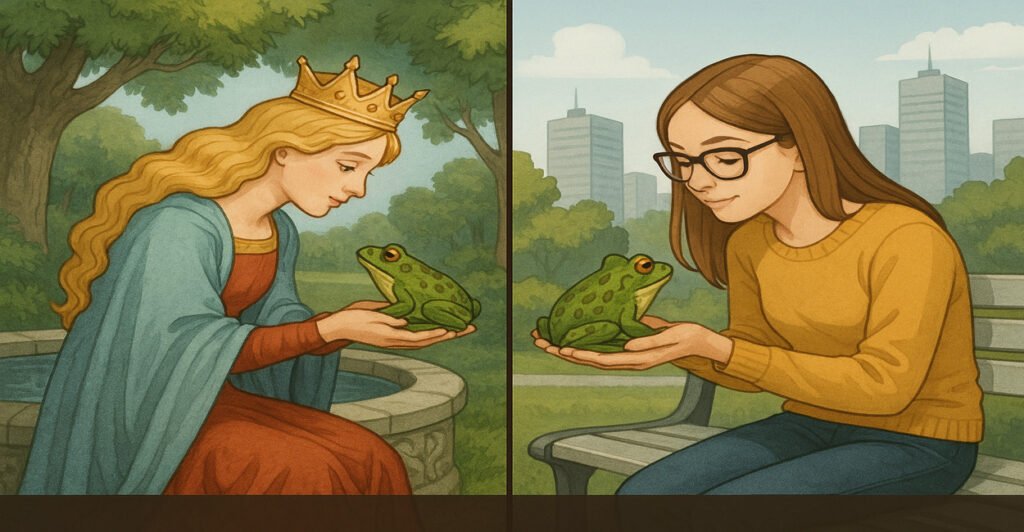Interested in Kids Fairytales?
Interested in Kids Fairytales?

Have you ever wondered how classic fairy tales evolve? The Frog Prince is one such story that has undergone fascinating transformations. From its ancient origins to modern retellings, this beloved fairy tale captivates audiences.
At Storyious, we celebrate timeless tales, and today, we’ll explore how The Frog Prince has changed, comparing traditional versions with contemporary adaptations. Whether you’re a fan of classic fairy tales or enjoy fresh twists, this deep dive will reveal the magic behind this enduring story.
The frog prince fairy tale has roots in ancient folklore. One of the earliest recorded versions comes from Germany, collected by the Brothers Grimm in their 1812 anthology. However, similar tales exist in Scottish, English, and even Chinese folklore.
In the Grimm version, a spoiled princess reluctantly befriends a frog after he retrieves her golden ball from a pond. When she throws him against a wall in frustration, he transforms into a handsome prince.
Traditional versions of The Frog Prince emphasize timeless themes that continue to resonate with readers today. These lessons made the story a staple in children’s literature.
The princess initially refuses to honor her deal with the frog, teaching children the importance of integrity. Breaking one’s word often leads to unintended consequences, reinforcing why honesty matters.
The frog’s true worth is revealed through patience, showing that true value lies beyond looks. This lesson encourages readers to treat others with respect, no matter how different they may seem.
Some versions suggest a kiss breaks the spell, symbolizing how compassion can change destinies. This magical element reinforces the idea that love and kindness hold real power.
By embedding these morals in an enchanting story, The Frog Prince has remained a beloved fairy tale for generations.
Disney’s The Princess and the Frog (2009) is one of the most famous modern adaptations. Unlike the original, this version features Tiana, a hardworking waitress who dreams of owning a restaurant. When she kisses a frog prince named Naveen, she turns into a frog herself!
Key differences from the classic tale:
Tiana is independent and ambitious, breaking the traditional princess mold. Her determination to achieve her dreams through hard work makes her a relatable role model for modern audiences.
Like Ray from Princess and the Frog, a lovable firefly who helps guide the protagonists. These supporting characters add depth and humor to the story’s magical journey.
The setting of 1920s New Orleans blends fantasy with real historical flair. This vibrant backdrop infuses the story with rich cultural elements and toe-tapping musical numbers.
These modern twists keep the essence of the original tale while making it more engaging for contemporary viewers. The film’s success proves how classic stories can be reinvented for new eras.
Modern books and films often reimagine The Frog Prince with fresh perspectives:
Some stories feature a female frog and a male protagonist, flipping traditional expectations. This twist challenges conventional fairy tale dynamics in thought-provoking ways.
Certain retellings explore curses and darker themes for mature audiences. These versions often delve into the psychological aspects of transformation and identity.
Characters like Lottie from The Princess and the Frog add much-needed diversity. Their inclusion helps modern children see themselves reflected in magical stories.
The timeless fairy tale of The Frog Prince has evolved significantly over the centuries. While the core idea of a frog transforming into a prince remains, the storytelling approach, characters, and underlying messages have shifted. Below, we break down the key differences between traditional and modern versions.
In the classic Brothers Grimm version (1812), the story follows a spoiled princess who reluctantly befriends a frog after he retrieves her golden ball from a pond. When she angrily throws him against a wall (not a kiss!), he transforms into a prince. The curse’s origin is vague, often attributed to a wicked fairy or witch.
Modern retellings, like Disney’s The Princess and the Frog (2009), expand the curse’s backstory. Prince Naveen is turned into a frog by the villainous Dr. Facilier, and Tiana’s kiss doesn’t break the spell instead, she becomes a frog too! The journey to reverse the curse becomes a central plot, adding adventure and deeper conflict.
Key Changes:
Transformation Trigger: Classic = violence (throwing the frog); Modern = love, self-discovery, or a quest.
Curse Origins: Older tales leave it mysterious; newer versions explain it (e.g., voodoo magic in Disney’s film).
Traditional Princess
A bratty, entitled princess who resists helping the frog. Her character arc focuses on learning humility and keeping promises through forced circumstances.
Modern Princess (Tiana)
Ambitious, hardworking, and kind, her dream isn’t just marriage but owning a restaurant. She represents a new generation of princesses who actively shape their destinies through determination and courage.
A silent, patient frog waiting for rescue. His passive role emphasizes the princess’s journey rather than his development.
Charismatic but lazy, he grows into responsibility through his journey. His character arc shows that true transformation requires active effort and self-improvement.
The Grimm version teaches:
Newer adaptations focus on:
Hard Work Pays Off
Tiana’s restaurant dream shows that success comes through perseverance. Her journey teaches that dreams require both vision and tireless effort to achieve.
Love Isn’t Instant
Naveen and Tiana’s friendship-to-romance arc demonstrates that real connections develop gradually. Their relationship grows organically through mutual respect and shared experiences.
True Transformation Is Internal
Both characters’ emotional maturity proves real change comes from within. Their physical transformation simply mirrors the personal growth they’ve already achieved.
Traditional Setting
Generic medieval kingdom with European fairy tale aesthetics. This timeless-but-unspecific approach allowed universal application across cultures.
Modern Setting
The Princess and the Frog is set in 1920s New Orleans, blending jazz, Creole culture, and voodoo lore. This vibrant historical setting adds authenticity while introducing audiences to African-American traditions and Southern charm.
Modern retellings resonate with today’s audiences by:
Giving children from all backgrounds characters they can see themselves in. This representation helps foster empathy and self-esteem in young readers from underrepresented communities.
Updating classic stories while keeping their magical essence intact. These thoughtful revisions allow new generations to fall in love with the same fundamental story in ways that speak to their experiences.
Showing how core values like kindness and perseverance remain relevant across generations. Modern contexts help children understand how these virtues apply in today’s world while maintaining the story’s enchanting quality.
Fairy tales endure because they adapt. The Frog Prince remains popular because:
From ancient folklore to animated films, The Frog Prince continues to enchant new generations with its timeless magic. Whether you prefer the classic Grimm version’s simple morality or modern twists like The Princess and the Frog that celebrate ambition and cultural diversity, this tale proves that great stories never fade they evolve to reflect our changing world. Each retelling adds fresh layers while preserving the core wonder that has captivated audiences for centuries.
At Storyious, we love sharing fairy tales in all their forms, from the oldest folk traditions to contemporary reimaginings. Our collection celebrates how these stories grow alongside society, offering new lessons while keeping their enchanting spirit alive. Explore with us and discover how The Frog Prince and other magical tales continue to inspire, teach, and entertain readers of all ages!
Let the journey through these ever-evolving stories begin. Where will your imagination leap next?
Join our community of story writers crafting original fiction across genres. Get published, be read, and make an impact.

Take our 10-minute quiz, with lifelines and swapping options, for a quick and reliable snapshot of your English proficiency.
Lorem ipsum dolor sit amet consectetur adipisicing elit. Quas magni cupiditate aliquauibusdam nostrum accusantium fuga delectus quo exercitationem!
Where Every Story Sparks a New Adventure!
At Storyious, talented writers transform their ideas into captivating narratives that inspire, entertain, and connect readers of all ages. With a deep commitment to creativity and excellence, every story we publish is authentic, human-crafted, and carefully curated to spark imagination and leave a lasting impact.
Stay connected with Storyious! Subscribe now to get the latest stories, featured reads, and exciting updates delivered straight to your inbox, never miss a magical moment.
2025 © Storyious | POWERED BY Storyious
Get ready for something extraordinary! We’re about to launch a powerful new feature that will redefine how you read, experience, and connect with stories. It’s bold, it’s brilliant, and it’s just around the corner
Keep checking back, because the future of storytelling is about to unfold, only on Storyious. Are you ready to be amazed?
Love stories? Join our community of story lovers today and don’t miss a single tale! Subscribe to Storyious and get the latest stories, featured reads, and exclusive content delivered straight to your inbox. Whether you enjoy magical fairytales, moral lessons, or bedtime classics, there’s always something new waiting for you.
You’ve successfully subscribed to our newsletter.
We’re excited to keep you updated with our latest news and offers.
You’ve successfully subscribed to our newsletter.
We’re excited to keep you updated with our latest news and offers.
We’ve received your message! Due to a high volume of inquiries, our team typically takes 3 to 5 working days to respond. We appreciate your patience and look forward to assisting you shortly. Stay connected!
You’ve successfully submitted your story. Our editorial team will review your story to ensure it aligns with our storytelling standards and content guidelines.
If your story meets our criteria, it will be accepted and published within 5 business days. Due to the high volume of submissions we receive, we may not be able to respond individually to stories that do not meet our editorial needs.
If your story is not published within 15 days, it may indicate that it was not selected for publication at this time. Thank you for contributing to Storyious; we truly value your voice and creativity!
Thank you for your interest in advertising with Storyious! Our team has received your request. We will carefully review your submission and get back to you within the next 3 to 5 working days. If you have any urgent queries or want to follow up, please contact us.
We look forward to helping you connect with an enthusiastic, global story-reading community.
Comments